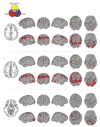Aberrant functional connectivity in autism: evidence from low-frequency BOLD signal fluctuations
- PMID: 19401185
- PMCID: PMC2766184
- DOI: 10.1016/j.brainres.2008.12.076
Aberrant functional connectivity in autism: evidence from low-frequency BOLD signal fluctuations
Abstract
A number of recent studies have examined functional connectivity in individuals with Autism Spectrum Disorders (ASD), generally converging on the finding of reduced interregional coordination, or underconnectivity. Underconnectivity has been reported between many brain regions and across a range of cognitive tasks, and has been proposed to underlie behavioral and cognitive impairments associated with ASD. The current study employed functional connectivity MRI (fcMRI) to examine interregional correlations of low-frequency BOLD signal fluctuations in 10 high-functioning participants with ASD and 10 typically developing control participants. Whole-brain connectivity with three seed regions of interest (left middle frontal, left superior parietal, and left middle occipital cortex) was evaluated using fMRI datasets acquired during performance of a source recognition task. While fcMRI patterns were found to be largely similar across the two groups, including many common areas, effects for the ASD group were generally more extensive. These findings, although inconsistent with generalized underconnectivity in ASD, are compatible with a model of aberrant connectivity in which the nature of connectivity disturbance (i.e., increased or reduced) may vary by region. Taking into consideration methodological factors that might influence measured fcMRI effects, we suggest that ASD is associated with an inefficiency in optimizing network connections to achieve task performance.
Figures

Similar articles
-
A big-world network in ASD: dynamical connectivity analysis reflects a deficit in long-range connections and an excess of short-range connections.Neuropsychologia. 2011 Jan;49(2):254-63. doi: 10.1016/j.neuropsychologia.2010.11.024. Epub 2010 Nov 24. Neuropsychologia. 2011. PMID: 21110988
-
Partially enhanced thalamocortical functional connectivity in autism.Brain Res. 2006 Aug 9;1104(1):160-74. doi: 10.1016/j.brainres.2006.05.064. Epub 2006 Jul 7. Brain Res. 2006. PMID: 16828063
-
Underconnected, But Not Broken? Dynamic Functional Connectivity MRI Shows Underconnectivity in Autism Is Linked to Increased Intra-Individual Variability Across Time.Brain Connect. 2016 Jun;6(5):403-14. doi: 10.1089/brain.2015.0389. Epub 2016 Apr 22. Brain Connect. 2016. PMID: 26973154 Free PMC article.
-
Distortions and disconnections: disrupted brain connectivity in autism.Brain Cogn. 2011 Feb;75(1):18-28. doi: 10.1016/j.bandc.2010.10.005. Epub 2010 Nov 4. Brain Cogn. 2011. PMID: 21055864 Review.
-
Autism as a neural systems disorder: a theory of frontal-posterior underconnectivity.Neurosci Biobehav Rev. 2012 Apr;36(4):1292-313. doi: 10.1016/j.neubiorev.2012.02.007. Epub 2012 Feb 14. Neurosci Biobehav Rev. 2012. PMID: 22353426 Free PMC article. Review.
Cited by
-
Alterations of local spontaneous brain activity and connectivity in adults with high-functioning autism spectrum disorder.Mol Autism. 2015 May 24;6:30. doi: 10.1186/s13229-015-0026-z. eCollection 2015. Mol Autism. 2015. PMID: 26023326 Free PMC article.
-
Resting State Functional Connectivity MRI among Spectral MEG Current Sources in Children on the Autism Spectrum.Front Neurosci. 2016 Jun 9;10:258. doi: 10.3389/fnins.2016.00258. eCollection 2016. Front Neurosci. 2016. PMID: 27375419 Free PMC article.
-
Functional and structural MR imaging in neuropsychiatric disorders, part 2: application in schizophrenia and autism.AJNR Am J Neuroradiol. 2012 Dec;33(11):2033-7. doi: 10.3174/ajnr.A2800. Epub 2011 Dec 15. AJNR Am J Neuroradiol. 2012. PMID: 22173749 Free PMC article. Review.
-
EEG complexity as a biomarker for autism spectrum disorder risk.BMC Med. 2011 Feb 22;9:18. doi: 10.1186/1741-7015-9-18. BMC Med. 2011. PMID: 21342500 Free PMC article.
-
Defining the contribution of CNTNAP2 to autism susceptibility.PLoS One. 2013 Oct 17;8(10):e77906. doi: 10.1371/journal.pone.0077906. eCollection 2013. PLoS One. 2013. PMID: 24147096 Free PMC article.
References
-
- Alexander AL, Lee JE, Lazar M, Boudos R, Dubray MB, Oakes TR, Miller JN, Lu J, Jeong EK, McMahon WM, Bigler ED, Lainhart JE. Diffusion tensor imaging of the corpus callosum in Autism. Neuroimage. 2007;34:61–73. - PubMed
-
- Arfanakis K, Cordes D, Haughton VM, Moritz CH, Quigley MA, Meyerand ME. Combining independent component analysis and correlation analysis to probe interregional connectivity in fMRI task activation datasets. Magn Reson Imaging. 2000;18:921–30. - PubMed
-
- American Psychiatric Association. Diagnostic and statistical manual of mental disorders (text revision) Washington, D.C.: 2000.
-
- Barnea-Goraly N, Kwon H, Menon V, Eliez S, Lotspeich L, Reiss AL. White matter structure in autism: preliminary evidence from diffusion tensor imaging. Biol Psychiatry. 2004;55:323–6. - PubMed
-
- Belmonte MK, Cook EH, Jr, Anderson GM, Rubenstein JL, Greenough WT, Beckel-Mitchener A, Courchesne E, Boulanger LM, Powell SB, Levitt PR, Perry EK, Jiang YH, DeLorey TM, Tierney E. Autism as a disorder of neural information processing: directions for research and targets for therapy. Mol Psychiatry. 2004;9:646–63. - PubMed
Publication types
MeSH terms
Grants and funding
LinkOut - more resources
Full Text Sources
Medical

